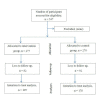Effectiveness of a Web-Based Health Education Program to Promote Oral Hygiene Care Among Stroke Survivors: Randomized Controlled Trial
- PMID: 28363880
- PMCID: PMC5392212
- DOI: 10.2196/jmir.7024
Effectiveness of a Web-Based Health Education Program to Promote Oral Hygiene Care Among Stroke Survivors: Randomized Controlled Trial
Abstract
Background: Oral hygiene care is of key importance among stroke patients to prevent complications that may compromise rehabilitation or potentially give rise to life-threatening infections such as aspiration pneumonia.
Objective: The aim of this study was to evaluate the effectiveness of a Web-based continuing professional development (CPD) program on "general intention" of the health carers to perform daily mouth cleaning for stroke patients using the theory of planned behavior (TPB).
Methods: A double-blind cluster randomized controlled trial was conducted among 547 stroke care providers across 10 hospitals in Malaysia. The centers were block randomized to receive either (1) test intervention (a Web-based CPD program on providing oral hygiene care to stroke patients using TPB) or (2) control intervention (a Web-based CPD program not specific to oral hygiene). Domains of TPB: "attitude," "subjective norm" (SN), "perceived behavior control" (PBC), "general intention" (GI), and "knowledge" related to providing oral hygiene care were assessed preintervention and at 1 month and 6 months postintervention.
Results: The overall response rate was 68.2% (373/547). At 1 month, between the test and control groups, there was a significant difference in changes in scores of attitude (P=.004) and subjective norm (P=.01), but not in other TPB domains (GI, P=.11; PBC, P=.51; or knowledge, P=.08). At 6 months, there were significant differences in changes in scores of GI (P=.003), attitude (P=.009), SN (P<.001) and knowledge (P=.001) between the test and control groups. Regression analyses identified that the key factors associated with a change in GI at 6 months were changes in SN (beta=.36, P<.001) and changes in PBC (beta=.23, P<.001).
Conclusions: The Web-based CPD program based on TPB increased general intention, attitudes, subjective norms, and knowledge to provide oral hygiene care among stroke carers for their patients. Changing subjective norms and perceived behavioral control are key factors associated with changes in general intention to provide oral hygiene care.
Trial registration: National Medical Research Register, Malaysia NMRR-13-1540-18833 (IIR); https://www.nmrr.gov.my/ fwbLoginPage.jsp.
Keywords: cerebrovascular accident; computer-aided learning; health care providers, Internet; oral hygiene; theory of planned behavior.
©Normaliza Ab Malik, Sa'ari Mohamad Yatim, Otto Lok Tao Lam, Lijian Jin, Colman Patrick Joseph McGrath. Originally published in the Journal of Medical Internet Research (http://www.jmir.org), 31.03.2017.
Conflict of interest statement
Conflicts of Interest: None declared.
Figures
References
-
- Friese CR, Kalisch BJ, Lee KH. Patterns and correlates of missed nursing care in inpatient oncology units. Cancer Nurs. 2013;36(6):E51–7. doi: 10.1097/NCC.0b013e318275f552. http://europepmc.org/abstract/MED/23151503 - DOI - PMC - PubMed
-
- El-Solh AA, Pietrantoni C, Bhat A, Okada M, Zambon J, Aquilina A, Berbary E. Colonization of dental plaques: a reservoir of respiratory pathogens for hospital-acquired pneumonia in institutionalized elders. Chest. 2004 Nov;126(5):1575–82. doi: 10.1378/chest.126.5.1575.S0012-3692(15)31374-X - DOI - PubMed
Publication types
MeSH terms
LinkOut - more resources
Full Text Sources
Other Literature Sources
Medical


